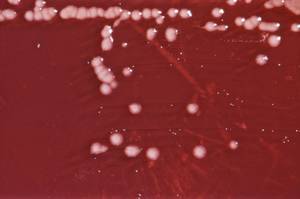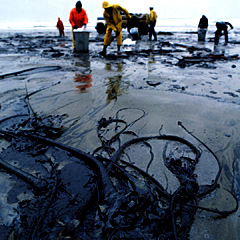This Week in Science History - The First Genetic Patent
Interview with
This week in science history, in 1981, saw the issuing of a patent to Ananda Mohan Chakrabarty for a genetically modified Pseudomonas bacterium that would eat up oil spills, the first patent of its kind.
 This was not the first bacterium to be engineered to do something that would be of use to humans - in 1978, Herbert Boyer engineered an E. coli bacterium that would produce human insulin, revolutionising and hugely improving treatment for diabetes - human insulin being much more effective than pig insulin, which was being used at the time.
This was not the first bacterium to be engineered to do something that would be of use to humans - in 1978, Herbert Boyer engineered an E. coli bacterium that would produce human insulin, revolutionising and hugely improving treatment for diabetes - human insulin being much more effective than pig insulin, which was being used at the time.
So the really important thing about this granting of the patent to Chakrabarty was not the fact that this group had modified an organism that would clean up oil spills, but that it set the precedent for the ability to get a patent for an animal or organism that had been genetically modified.
This was after a lengthy court case in 1980 that went right up to the Supreme Court of the United States, where the opposers to Chakrabarty's application for the patent argued that according to the United States constitution, living organisms could not be patented. The team defending Chakrabarty argued that the fact that the bacteria were living organisms was irrelevant, as it also states in the constitution that any novel process or technology created by man could be patented, and that this being a new species of bacteria, created by man, fell into this category. The Court ruled in Chakrabarty's favour.
There are 4 species of oil eating bacteria in the genus Pseudomonas, each using a different component of the oil as a food source, but when added to a sample of oil together, they compete with each other - like any four species would do if all put together with a food source that they all want to eat. This meant that the oil wasn't cleaned up very efficiently or very quickly.
 Bacteria contain plasmids, rings of DNA that code for the proteins they produce. Differences in this DNA will lead to proteins allow the bacteria to use oil, methane, sugar, sulphur or many other things as food. Chakrabary's team took the plasmids from the four species of oil-eating bacteria and put them all into a single bacteria. Usually these plasmids would not all cooperate in the same cell, but exposing the cell to ultraviolet light made the plasmids join into one that could use all 4 pathways of the original plasmids to break down several different components of oil.
Bacteria contain plasmids, rings of DNA that code for the proteins they produce. Differences in this DNA will lead to proteins allow the bacteria to use oil, methane, sugar, sulphur or many other things as food. Chakrabary's team took the plasmids from the four species of oil-eating bacteria and put them all into a single bacteria. Usually these plasmids would not all cooperate in the same cell, but exposing the cell to ultraviolet light made the plasmids join into one that could use all 4 pathways of the original plasmids to break down several different components of oil.
[CORRECTION - Ed]Due to concerns at the time about releasing genetically modified organisms into the environment, Chakrabarty's team decided to test the use of just the oil-degrading compounds, called biosurfactants, that the bacteria make. The Pseudomonas biosurfactants proved effective against the oil of the disastrous Exxon Valdez spill in 1989 in a test carried out by Chakrabarty, but was not used in the field, despite the tests also showing that the bacterial oil-degrading compounds were much less toxic than synthetic ones already in use. Professor Chakrabarty still hopes that his Pseudomonas surfactants will be used in oil spills one day.
Many other genetically engineered organisms have been patented since then, from bacteria used in mineral extraction up to mice and rats used to study genetic disorders, known as knock-outs. The ability to engineer the genomes of organisms has had huge medical, industrial and environmental benefits, but it still remains controversial, especially in agriculture.
- Previous Tackling Tuberculosis
- Next South Africa Escapades









Comments
Appreciating
I want to become like you
Gentic engineering
In tamilnadu chennai seashore there were oil spills why we are not use superbug
Add a comment